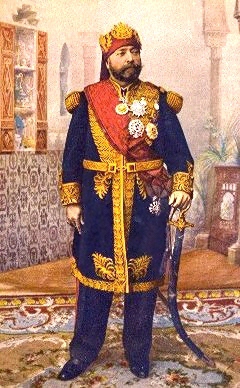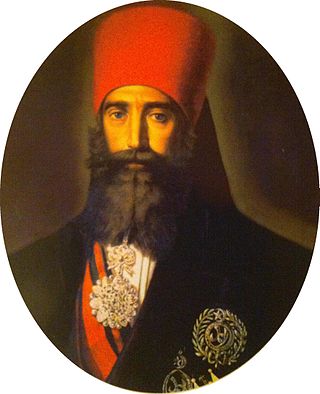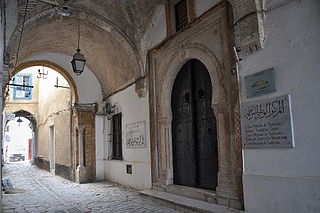
The Hammam-Lif Palace was a winter residence of the Tunisian Beys, in Hammam-Lif, Tunisia. It was a favourite residence of the Husainid dynasty, but it is now in an advanced state of dilapidation.

The Hammam-Lif Palace was a winter residence of the Tunisian Beys, in Hammam-Lif, Tunisia. It was a favourite residence of the Husainid dynasty, but it is now in an advanced state of dilapidation.





In addition to their residences in Bardo, La Marsa, and La Manouba, the monarchs of the Husainid dynasty gradually developed the habit, starting in the 18th century, of staying more and more often in Hammam Lif during the winter. [1] In the mid-century, it was their interest in the baths of Hammam Lif that led the beys to build a permanent residence there. [1] A pavilion was built around 1750, during the reign of Ali Bey I (1688–1756), thanks to the thermal waters that emerge at the foot of Jebel Boukornine from two sources named Aïn El Bey and Aïn El Ariane. [1]
In 1826, Hussein II Bey (1784–1835) decided to build a palace next to a Caravanserai; the majority of this building still exists today. [1] The building, upon completion of the works, includes a massive ground floor and two floors, with twenty windows with awnings overlooking the sea. [1] At the northwest corner of the palace, Hussein II Bey built a kiosk, Bit el-Makaaad, a kind of covered but not enclosed gallery where he spent his leisure hours. [1] He also built private baths, accessible from the outside; reserved for the exclusive use of women, these baths are complemented by a second bath open to men, in the opposite part of the palace. [1]
Muhammad Bey (1811–1859) added a third floor to Hussein II Bey's palace; he also modified Bit el-Makaaad. [1] During the reign of Nasir Bey (1855–1922), the third floor, which was in danger of collapse, was removed. However, he restored and furnished several rooms, as well as the service apartments. [1] Since Hussein II Bey, and with the exception of Ali III Bey (1817–1902) and his son Hédi Bey (1855–1906), all sovereigns stayed at the palace until the abolition of the monarchy in 1957. [1]
After Tunisian Independence in 1956, the beylical palace housed a women's vocational training center. Subsequently, families in need occupied it and transformed it into an oukala (collective residence). Today, in the absence of restoration, the palace is in an advanced state of dilapidation.
On 15 March 2022, the palace was classified as a monument. [2]

Muhammad III as-Sadiq commonly known as Sadok Bey, was the Husainid Bey of Tunis from 1859 until his death. Invested as Bey al-Mahalla on 10 June 1855, he succeeded his brother Muhammad II ibn al-Husayn on 23 September 1859. Named as divisional General in the Imperial Ottoman Army on 10 June 1855, he was promoted to the rank of Marshal on 10 December 1859.

Muhammad V an-Nasir, commonly known as Naceur Bey was the son of Muhammad II ibn al-Husayn and the fifteenth Husainid Bey of Tunis, ruling from 1906 until his death. He was named Divisional General of the Beylical army when he became Bey al-Mahalla on 11 June 1902, and assumed the rank of Marshal when he succeeded Muhammad IV al-Hadi on 11 May 1906.

Muhammad VIII al-Amin commonly known as Lamine Bey, was the last Bey of Tunis, and also the only King of Tunisia.

The Beylik of Tunis was a de facto independent state located in present-day Tunisia, formally part of the Ottoman Empire. It was ruled by the Husainid dynasty from 1705 until the establishment of the French protectorate of Tunisia in 1881. The term beylik refers to the monarch, who was called the Bey of Tunis. Under the protectorate, the institution of the Beylik was retained nominally, with the Husainids remaining as largely symbolic sovereigns.

Ahmad I, born 2 December 1805 in Tunis died 30 May 1855 at La Goulette, was the tenth Husainid Bey of Tunis, ruling from 1837 until his death. He was responsible for the abolition of slavery in Tunisia in 1846.

The Bardo National Museum is a museum of Tunis, Tunisia, located in the suburbs of Le Bardo.

Mohammed Bey or M'hamed Bey was the eleventh Husainid Bey of Tunis, ruling from 1855 until his death. He was the son of Al-Husayn II ibn Mahmud and his second wife Lalla Fatima al-Munastiri.
Hammuda Pasha Bey, died April 13, 1666 was the second Bey of the Tunisian Muradid dynasty. He reigned from 1631 until his death.
Dar Djellouli is an old palace of the medina of Tunis. It is located in the Street of the Rich in Bab Jedid, near Tourbet el Bey.

Dar Ben Ayed is an old palace of the medina of Tunis. It is located in the Ben Ayed Street in Bab Jedid, near Tourbet el Bey and Souk Es Sabbaghine.

Dar Hammuda Pasha is an old palace in the medina of Tunis. It is considered one of the oldest and biggest palaces of the medina that kept their original architecture.

Dar Caïd Nessim Samama is one of the palaces of the medina of Tunis.

Dar El Monastiri is a palace in the Medina of Tunis.
Lella Kmar was the queen consort of Tunisia during three reigns, after having successively married three beys of Tunisia: Muhammad III Sadiq, Ali III and Muhammad V Nasir, and despite this, she did not have children.

Mustapha Saheb Ettabaa, was a Tunisian politician and a mamluk of Georgian origin who served as a minister in the Beylik of Tunis.
Mohamed El Aziz Ben Achour is a Tunisian politician and historian born on 5 January 1951; he specializes in urban, social and cultural history of modern Tunisia and the Islamic civilization. He was the Minister of Culture some time between 2004 and 2008, and later Director-General of the Arab League Educational, Cultural and Scientific Organization (ALECSO) some time between 2009 and 2013.

Mohamedia Palace was a palace of the Tunisian Beys, in the town of Mohamedia, Tunisia. It was constructed as a retreat from the capital, Tunis, in the first half of the 19th century, but was already abandoned in the second half. Today, the palace is in ruins.

Dar al-Taj Palace was a palace of the Tunisian Beys, in La Marsa, Tunisia. It is 18 kilometers northeast from Tunis. The palace was constructed as a summer palace and retreat from the capital. It was destroyed in the years after the Tunisian independence. Nothing remains now, except for postcards that serve as reminders of the past glory of the Dar al-Taj.

The Ksar Saïd palace is a former palace of the Tunisian Beys in Le Bardo, a suburb of Tunis, Tunisia. It is close the other major residence of the Husainid dynasty, the Bardo palace. Since 2019, the palace is officially named Ksar Saïd, Palace of Letters and Arts, and is open to the public.

The Royal Palace of Carthage or nowadays Zarrouk Palace was a residence of the Tunisian Beys, in Carthage, Tunisia. The palace has influences from Ottoman styles, as well as Arab and Andalusian influences.